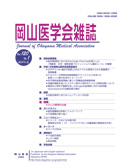

Journal of Okayama Medical Association
Published by Okayama Medical Association<Availability>
Full-text articles are available 3 years after publication.
Permalink : http://escholarship.lib.okayama-u.ac.jp/15880
Cholelitholytic therapy for cholesterol gallstones - Dissolution efficacy and biliary bile acid composition
Watanabe, Jun-ichi
Published Date
1987-04-30
Abstract
Eighty-three patients with cholesterol gallstones in a functioning gallbladder were treated with 400mg UDCA and 200mg CDCA (group A), 300mg UDCA and 300mg CDCA (group B), 200mg UDCA and 400mg CDCA (group C), 400mg CDCA alone (group D), 400mg CDCA and 240mg trihydroxy propiophenone (group E), or 600mg UDCA alone (group F). All patients were followed by cholecystography and ultrasonography. At the end of 6 months of treatment, the cumulative efficacy (complete plus partial dissolution) of all subjects were 41.0%. Twelve patients (14.5%) had complete dissolution. Group B had the highest dissolution rate (69.2%:38.5% complete and 30.7% partial dissolution), and this rate was significantly higher (p<0.01) than that of the CDCA-treated patients (group D). Diarrhea was frequently observed in patients treated with 400mg CDCA (27.8% in group D and 31.3% in group E). Combination with UDCA seemed to prevent this complication. No significant changes in the plasma lipids were observed. Changes in the bile acid composition, including lithocholic acid, did not seem to be determined solely by the doses of UDCA and CDCA. Patients whose lithogenic index dropped below 1.0 during the treatment did not always show dissolution of gallstones. Although the age of the patients, obesity and stone size did not affect the dissolution rate, the female sex and good gallbladder contractility were preferable factors for the dissolution of cholesterol gallstones.
Keywords
cholelitholytic therapy
ursodeoxycholic acid (UDCA)
chenodeoxycholic acid (CDCA)
trihydroxy propiophenone
lithogenic index
ISSN
0030-1558
NCID
AN00032489
